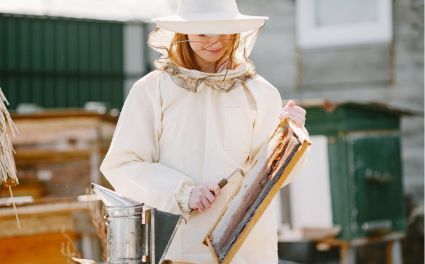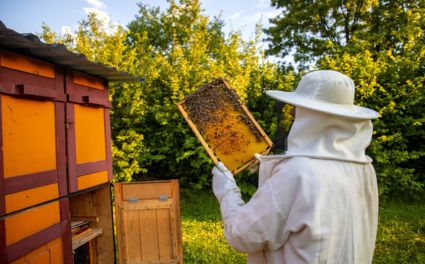Pull up a chair, partner, because today we’re diving into something a lot more folks are waking up to—how beekeeping plays a mighty big role in the health and success of modern farming. If you’ve ever scratched your head wondering why almond orchards bring in hives by the hundreds or why your neighbor’s sunflower fields buzz like a barroom on a Friday night, well, you’re about to find out.
This ain’t just about honey. It’s about survival—yours, mine, the farmers’, and the crops we rely on.
Let’s talk about beekeeping for farmers, and why more ranchers and growers are shaking hands with beekeepers every year to get those blossoms pollinated just right.
Why Farmers Are Bringing In The Bees: It Ain’t Just For The Honey
Out here in the real world, it’s easy to forget how much of our food depends on pollinators. But you ask any old-timer with an orchard or berry patch, and they'll tell you: no bees, no harvest.
Roughly 75% of the leading global food crops depend, at least in part, on animal pollination, and honeybees are the workhorses of that group. Whether it’s almonds, blueberries, apples, melons, or even canola, crop pollination by honeybees ensures flowers turn into fruit.
But here's the twist: the natural populations of pollinators just can't keep up anymore. Habitat loss, pesticides, and climate shifts have thinned out the wild bee numbers. So what do farmers do? They turn to the professionals.
That’s where folks like us come in—with managed bee colonies for crops. We saddle up our bees, haul them across counties and states, and set them loose to do what they do best: work the bloom.
What Does It Mean To Hire Bees?
Sounds funny, right? Hiring bees for flowering crops. But it’s a booming business.
See, a grower can’t always count on native pollinators to show up when a crop starts blooming. So instead, they pay a beekeeper to bring in hives at just the right time. Each colony houses thousands of foragers ready to roll, increasing pollination rates and boosting yields—sometimes by 30% or more.
These aren’t just wild bees running loose. They’re managed, monitored, and have healthy colonies. As beekeepers, we time our visits with flowering windows, check that our hives are strong, and make sure our bees stay put while they work. It’s precision pollination, and it pays.
And believe me, if you’ve ever seen a field that had hives versus one that didn’t, the difference is night and day.
How Do You Prep A Bee Yard For Agricultural Work?
Let me shoot straight with you: working bees for crop pollination is a whole different rodeo from backyard honey harvesting. These bees are on a mission, and they’ve got deadlines. You can’t just toss a hive on a pallet and hope for the best.
First thing? Suit up right. You're gonna be moving colonies, inspecting brood frames fast, and possibly doing it in tight windows between orchard sprays. I always trust my OZ Armour 3-layer ventilated beekeeping suits when I’m out in the field. It keeps me cool, sting-free, and able to focus on the bees, not the heat.
Next, you’ll want to haul strong colonies. Don’t show up with weak hives that can’t keep up. A standard almond contract, for example, might call for eight frames of brood and bees. Anything less and the grower’s gonna send you packing.
Keep your gear clean and solid. Beekeeping jackets, beekeeping trousers, and beekeeping gloves all matter when you’re doing long hours in the field. And don’t forget a durable bee veils for visibility and comfort.
When you’re juggling 40 hives in a row, the right tools make the difference. OZ Armour’s Hive Tools and Smoker with Heat Shield let me work fast without stressing the bees.
Pollination Schedules: Timing Is Everything
Out here, timing’s tighter than a rusty bolt. You miss the bloom, you miss the crop.
Every flowering crop has a sweet spot, usually just a few weeks when pollination counts. For almonds, it’s late winter to early spring. Apples follow, then cherries, then berries. Some crops need only a week or two of buzzing. Others, like melons or cucumbers, may require extended exposure.
That means coordination. A good grower will contact you ahead of bloom. You’ll truck your bees in, place them by sunup, and monitor their strength as the flowers pop open.
And yeah, you’ll likely be moving bees at night. Bees navigate by sunlight, and if you want to keep them calm, the dark is your friend. That’s when I break out my snug-fit beekeeping gloves for safe handling.
The Business Side Of Beekeeping For Pollination Contracts
Now, let’s get down to brass tacks—how does a beekeeper make money doing this?
Pollination contracts can be seasonal (like almonds) or rotational (like in vegetable crops). Fees are usually paid per hive, and they vary depending on:
-
The strength of your colonies (more bees = more $$$)
-
The crop type (some crops are more demanding)
-
The region and bloom window (shorter windows = premium pay)
It’s common to see anywhere from $100 to $250 per hive for almond pollination. Multiply that by 100 hives, and you’re talking real money. That said, you’ve gotta stay on top of mite control, nutrition, transportation, and documentation.
You’re not just selling bees—you’re selling a pollination service.
Challenges You’ll Want To Watch Out For
Pollination work is rewarding, but it ain’t always smooth sailing. You’ve got to watch for:
-
Pesticide Exposure: Not every grower plays by pollinator-safe rules.
-
Mite Infestations: High-density apiaries can trigger trouble fast.
-
Bee Drift and Robbing: Especially in massive orchards, where thousands of colonies are trucked in.
That’s why investing in full gear like ankle protection and strong beekeeping suits for kids (for family helpers) keeps everyone safe and comfortable.
Why Pollination Beekeeping Feels Like Real Ranch Work
There’s something raw and real about working bees for agriculture. It’s hard work, honest pay, and every season is different. Some years, the rains delay the bloom. Other times, late frost knocks it all back. But you show up, you do the job, and the land thanks you.
It’s not just about honey. It’s about feeding the world, quietly, one flower at a time.

Beekeeping And Farming: A Partnership That’s Here To Stay
When it comes right down to it, beekeeping isn’t just a sideline hobby anymore. It’s a cornerstone of modern agriculture. And if you’ve got the grit, the gear, and the bees, there’s a place for you in this growing space.
So, whether you’re a farmer thinking about hiring bees for flowering crops or a beekeeper eyeing your first pollination contract, remember: we’re not just working the land, we’re working together.
And if you're gearing up for the season, make sure your hives are healthy, your contracts are clear, and your tools are field-ready. Zip up your beekeeping jacket, grab your smoker, and get those colonies ready to roll.
Because out here in the fields, it ain’t just about bees—it’s about feeding the future.
👉 Want to keep learning? Read more blogs about beekeeping.












